Bournemouth were struggling in the relegation zone. But then, they travelled to the Etihad Stadium in week 36 of the Premier League, facing the Manchester City side that were recently granted the UEFA Champions League qualification for next season, and almost surprised the former champions of England. This was an intriguing battle, and even Pep Guardiola admitted his Manchester City did not control the game.
In this tactical analysis, we will dissect the tactics of Eddie Howe and Guardiola.
Lineups
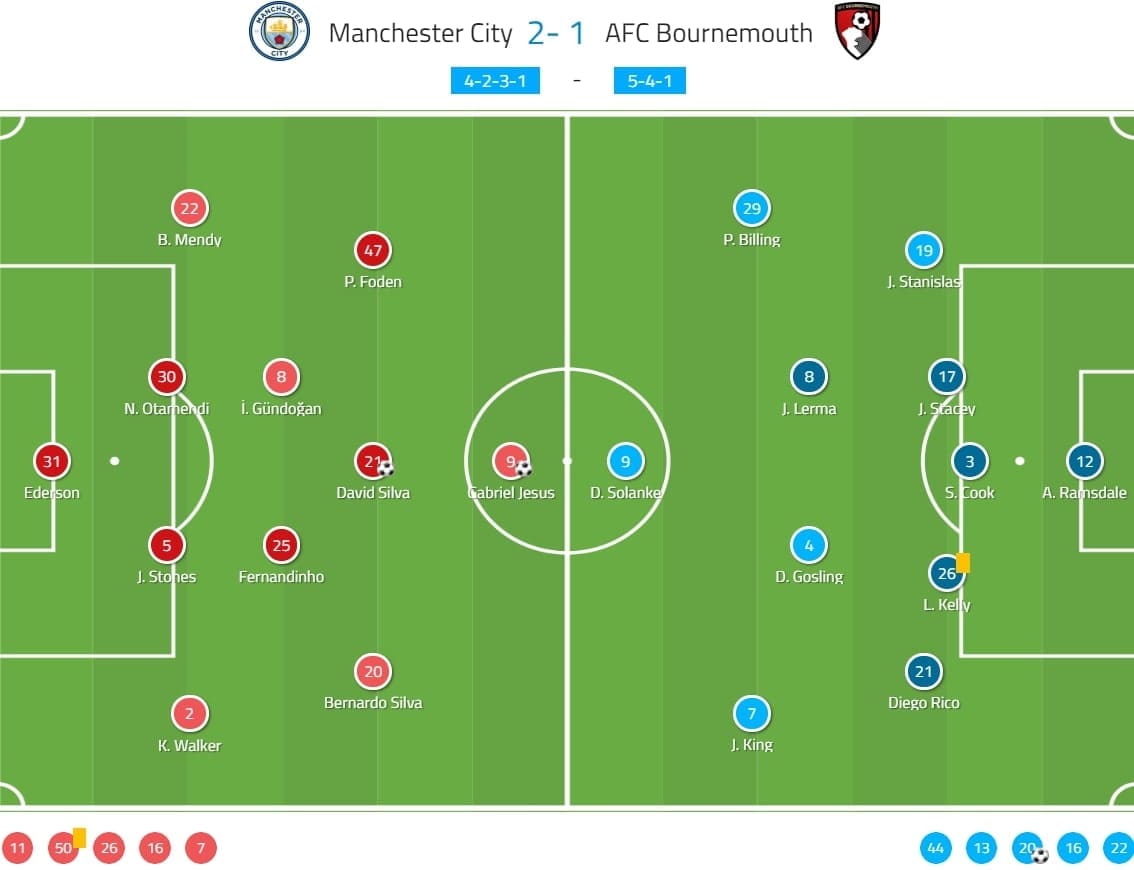
The home team rotated their lineup and most players that were used in the Brighton game were not used here. John Stones and Nicolás Otamendi were deployed at the centre of the defence. In midfield, David Silva, Fernandinho and İlkay Gündoğan returned while Gabriel Jesus was still the team’s striker. They played in a 4-2-3-1 formation.
On paper, the formation of Bournemouth was a 5-4-1 but it might not be true given what I have seen on the pitch. Instead, a 4-5-1 was more reasonable and it looked like a back five because of Junior Stanislas’ defensive duties. Dominic Solanke was the lone striker as Callum Wilson stayed on the bench.
Bournemouth’s defensive style of play
Guardiola has mentioned the pressing of the Cherries was very good, but this was not referring to the high pressing. Instead, Howe’s team tended to set a mid-block in the first half. What Pep referred to was the sustainable pressure on the ball that forced City to play quicker, which limited the quality of passes and the Citizens were not controlling the tempo and rhythm.
The defensive shape of the team was not important as the structure varied across different situations. The task of Stanislas and Joshua King was to contain and control the threat of the offensive City full-backs.
Apart from placing Solanke close to the second line and preventing the pivot from utilising the positional superiority, the continuous pressure on the ball was applied by the midfielders zonally. The Cherries had a midfield three which spread evenly in three vertical zones and were stepping out and approaching the carrier when the ball arrived in their zone. Since City were attacking with a double-pivot, the wide midfielders were required to press a lot in this game. For the back four, they mainly stayed compact horizontally.
Therefore, the formation could be a 4-4-2 sometimes. This was the structure when Phil Billing approached Gündoğan. When the ball was played to Stones, Billing returned to the second line and the defensive duty was shifted to Dan Gosling.
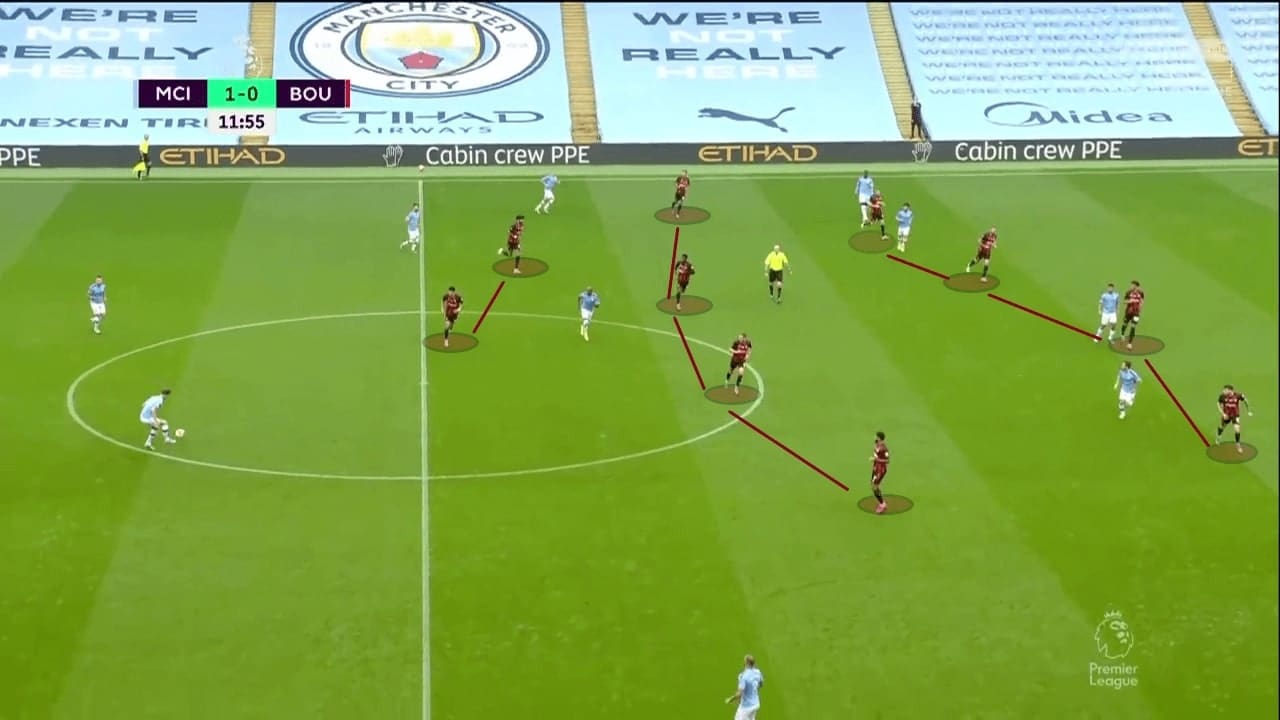
Bournemouth were quite disciplined, and the midfield was always horizontally compact. Unless City were quick enough to switch the ball between flanks, the second line often shadowed players between the lines. Stanislas had a great game in terms of covering the outer zone for the back four and limited the threat of Guardiola’s wide men.
Here, the shape became a 5-4-1 as Stanislas dropped as a right wing-back, allowing the back four to stay compact. This was vital as City were strong at making the half-space runs while the Cherries were trying to prevent this from happening.
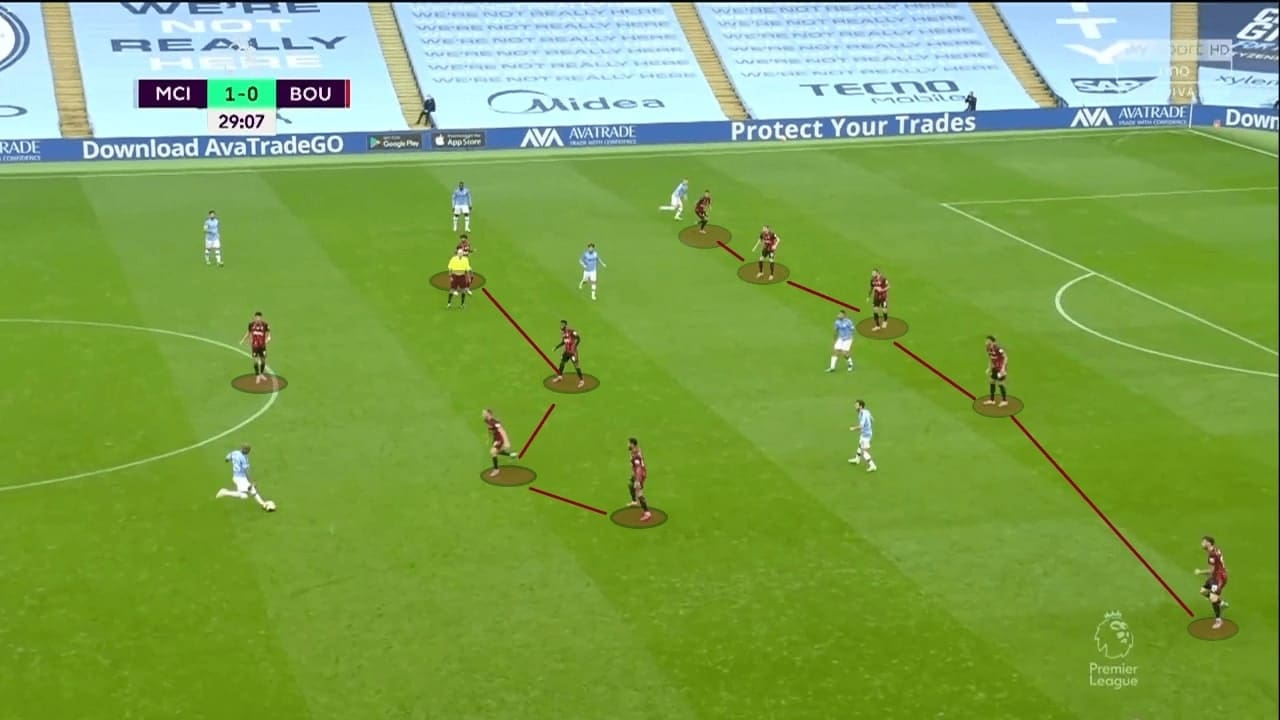
In some more extreme cases, City pushed Kyle Walker and Benjamin Mendy in the advanced wide zones. Bournemouth were aware of this and this could turn to a back six because of Stanislas and King’s commitment to defend.
Below, a 6-3-1 formation was drawn as the wingers have dropped to the defensive line. The tight control of City full-backs hindered the possibility of diagonal balls and threat in the wide areas.
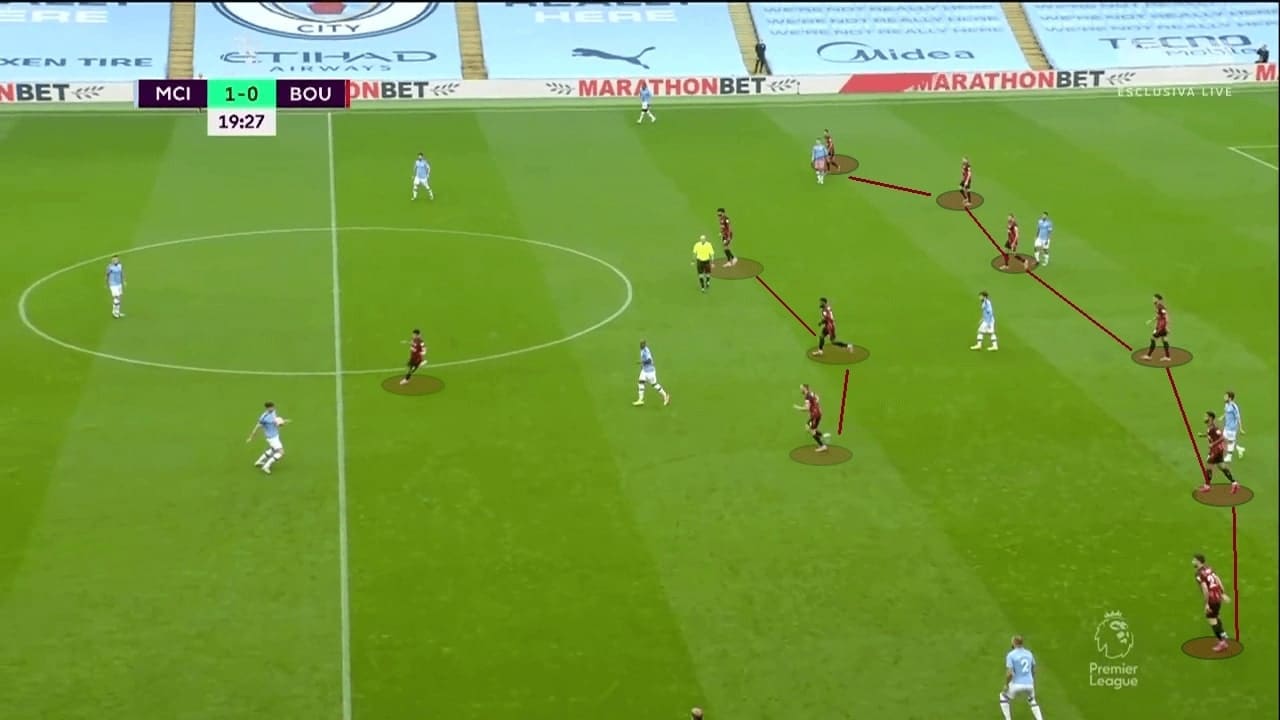
In the second half, Bournemouth were two goals down already and the pressing was more aggressive. Pressing high and even in City’s own third was a bold decision, but this has troubled City’s build-up a bit. Initially there were six pressing players while the four defenders stayed deeper to track any free players.
It was quite incredible as City’s goalkeeper – Ederson – was also a part of the build-up. In this scene, it was a 6 v 8 situation but Bournemouth applied continuous pressure on the ball. This adversely affected the passing quality of the opponents, especially for the long-ranged passes, and allowed the back four to regain possession at times.
Roughly speaking, it was a man-orientated system, but the midfielders were aggressive enough to step up. Billing was approaching Otamendi, though this might leave the passing lane to D. Silva open, but the pressure from Solanke did not give Ederson time to recognise this gap.
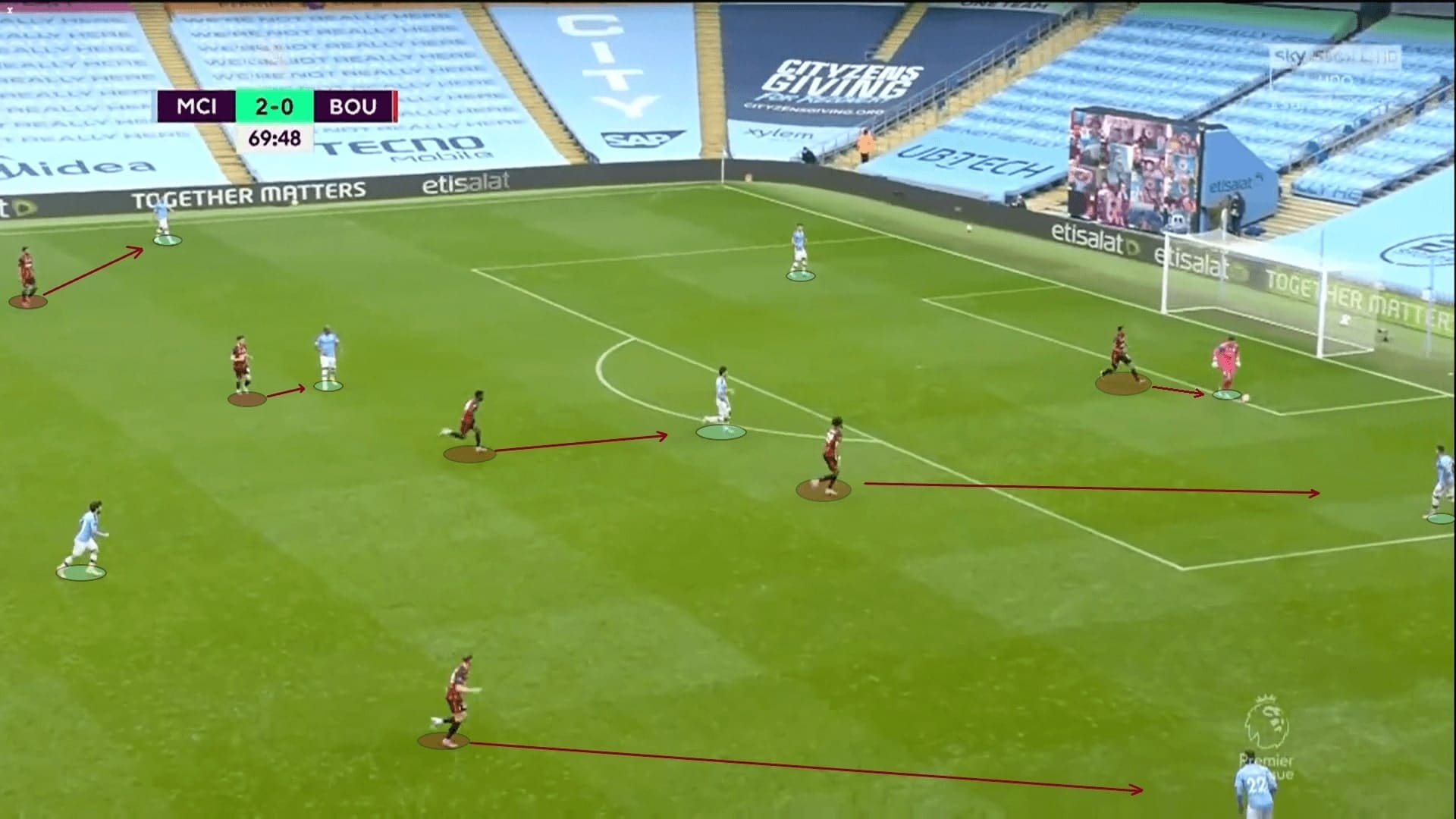
Moments of City brilliance
In general, City were below par although three points were secured. Offensively, Guardiola’s men have been very fluent and fluid to create the opportunities, utilising the principles of the positional plays. Apart from the Bournemouth pressure that made the Citizens’ build-up difficult, the structure was suboptimal in the first half.
Below is the passing map and average positions of City throughout 90 minutes. Note the boxed shape in the first phase, formed by the centre-backs (#5 and #30), Fernandinho (#25) and Gündoğan (#8). It was not a single pivot but more like a double pivot in the centre. Meanwhile, the full-backs stayed wide to provide the width, as can be seen from Mendy (#22) and Walker’s (#2) positions.
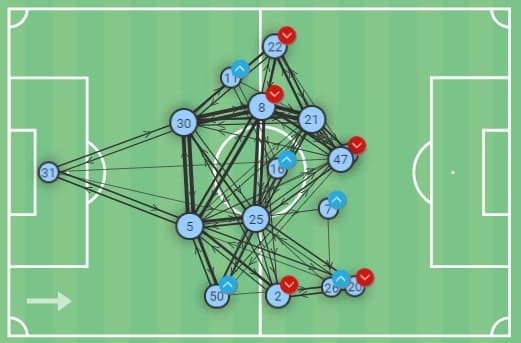
On paper, the idea was okay as the concepts of plays did not change. The clockwise rotations still appeared when Phil Foden, Mendy and D. Silva played together. The movements allowed these three to take their partner’s position. Through the movements when rotating, the opponents are moved in the process, which means spaces and passing lanes were available.
It should have worked as even Gündoğan appeared in the left half-space and he had three progressive options in the players we mentioned in the above analysis. However, this was not working because of the sustainability of pressure and compactness of defence.
Here, the only viable option was Mendy but Gündoğan would seldom connect with the left-back in that game. Passing vertically to D. Silva would be constrained by the nature of this type of pass – the receiver closed his body and a return pass would go back to the German international because the third man was unavailable.
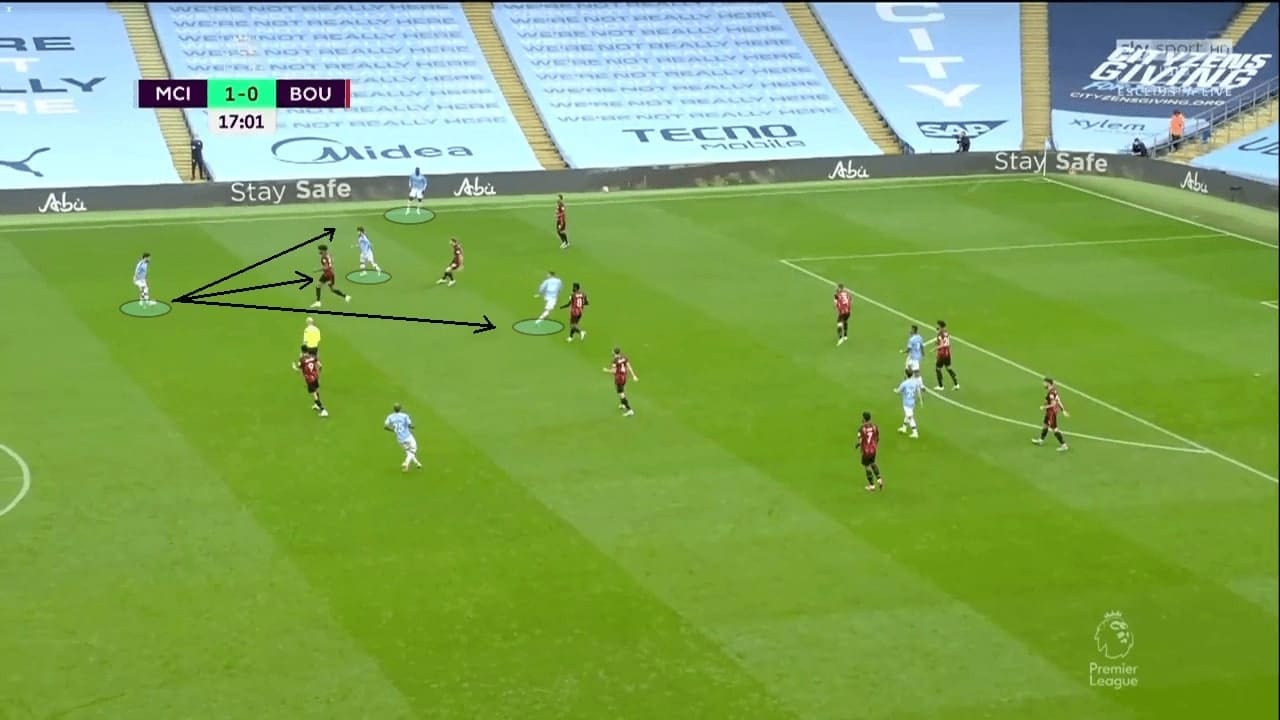
Only playing D. Silva as the advanced midfielder between the lines let Bournemouth defend easily. The manipulation on the second line was not enough and this was a reason that the Cherries’ midfielders were pressing without concerns.
During the ball circulations, it was impossible for D. Silva to move across both half-spaces as quick as the speed of the ball. This hindered the progression and even the wingers would come narrow, operating as hybrid players and temporary replacements of D. Silva. This was why Foden appeared in front of Gündoğan below.
However, the moments of the rotations were not precise enough – sometimes Foden just went to the same vertical zone as Gündoğan. The progression was difficult due to the constant pressure while the English youngster was receiving with a closed body shape.
In this example, Billing was clever to curve his run, which shielded the passing lane to Foden initially and forced Gündoğan to circulate the pass. D. Silva was too far away from supporting the attack while Fernandinho was staying at Gündoğan’s horizontal zone.
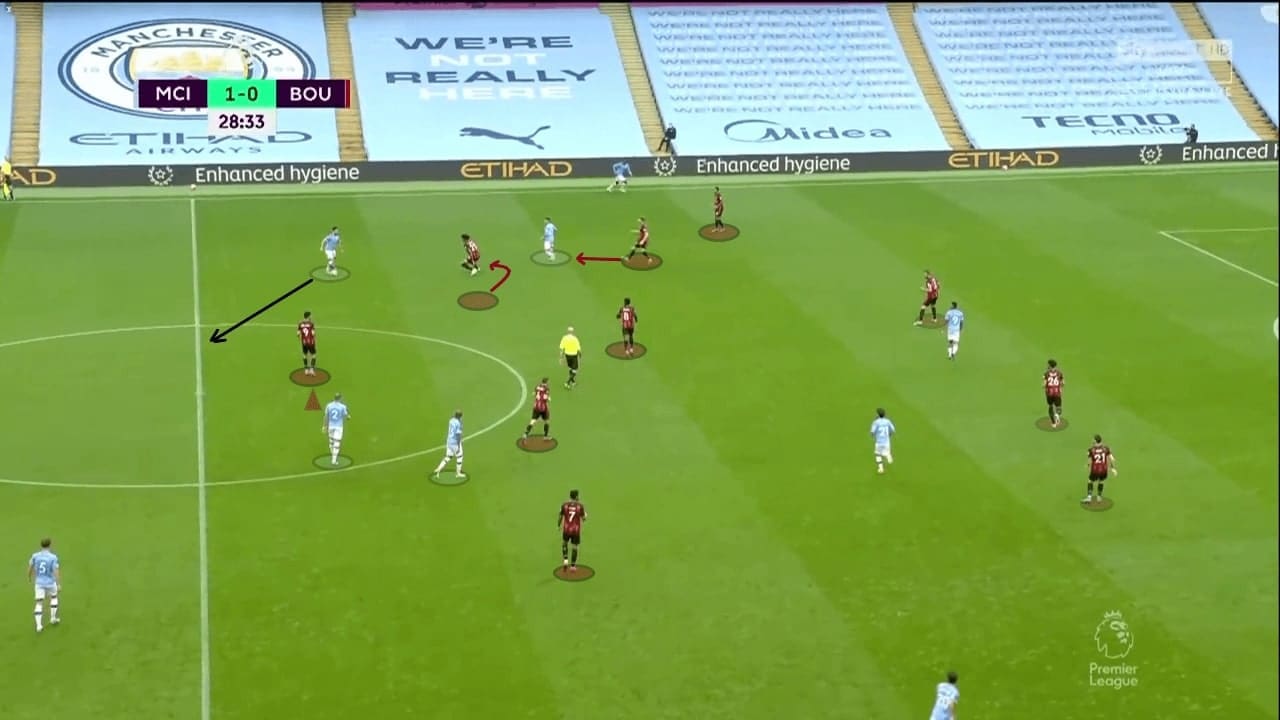
As mentioned, what helped City to win this game were the moments of brilliance. The home team was clinical to grab the chances created and scored a double before halftime. This example shows the second goal and the quality of individuals was the key.
The switch of plays was through Fernandinho this time. This was because Solanke was not staying tight enough to the midfield, different from the above case. Benefiting from this detail, D. Silva had the time to move from one half-spaces to another during the process. Mendy, as the left-back, was stretching Bournemouth horizontally and Stanislas was a step wider.
The moment we showed below was the 0.01 second that D. Silva used to scan the pitch when moving. The timing was excellent as the ball was yet to arrive at Gündoğan’s feet, and this allowed El Mago to gather visual information from the pitch, understanding Jack Stacey’s and Jesus’ positions.
Therefore, the killer pass to release the Brazilian international was quick and the Cherries could barely react. Let’s not forget the nutmegs from Jesus that had set the shooting angle before the ball went past Aaron Ramsdale.
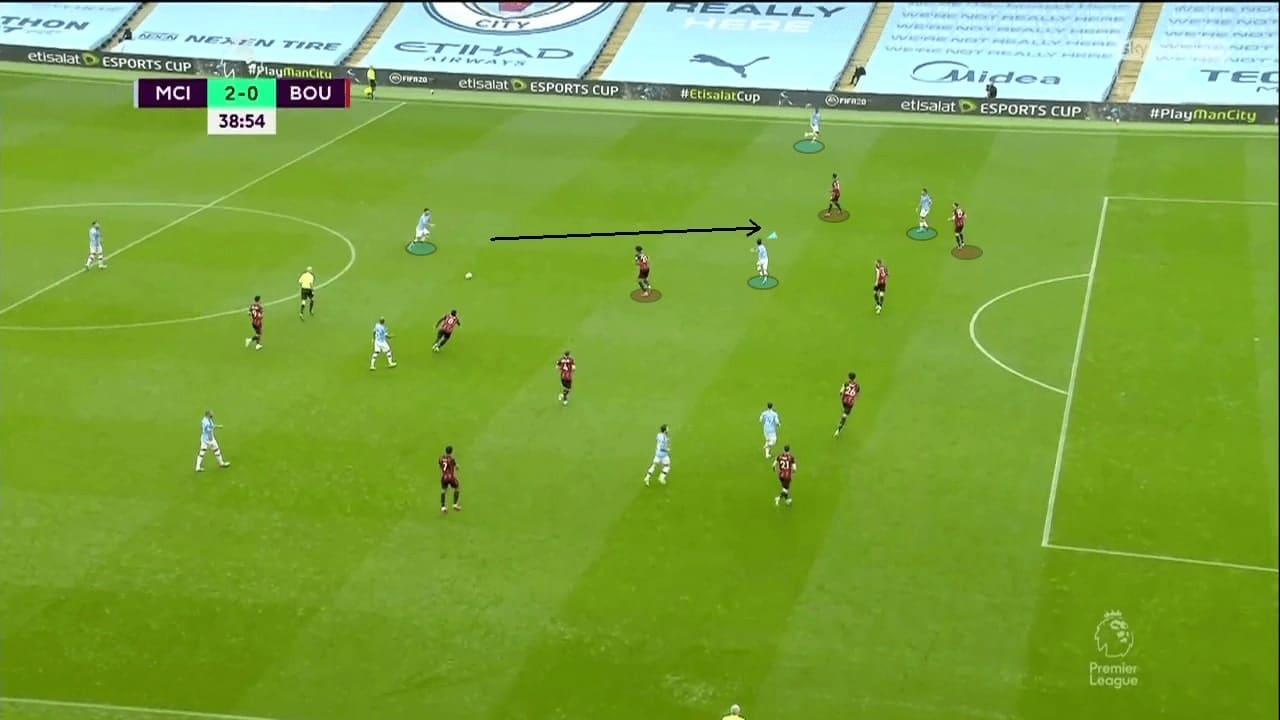
Transitions, set-pieces and second balls
Bournemouth and Howe knew the opponents were dominating the majority of possession. Apart from setting a tough defensive block, the performance in the transitions, set-pieces and second balls would be the key to score.
In the open plays, City were not giving the ball away sloppily too often despite facing difficulties in the build-up. Bournemouth did have some chances to regain possession and initiate a counter-attack, but the speed of the offensive transitions was limited because of the defensive shape. The lines and players were too compact off-the-ball. When regaining possession, the time required to open the shape was long and City bought time to regroup.
Sometimes Howe’s men were counter-attacking City’s exposed defence. Solanke often served as a target in the first moment and released the third man, who was supporting. Just like in this example, Jefferson Lerma was not the same as Allan Saint-Maximin or Yaya Touré would be – momentums were not utilised because the midfielders were not good at carrying the ball with speed.

Thanks to the well-planned set-pieces, using Billing as the main target, Bournemouth created most of the chances when City players committed silly fouls or through corners. The 24-year-old Danish midfielder is 1.93m tall according to Trasnfermarkt, and this physical superiority was a great asset to the team.
Billing was often the target of indirect freekicks, operating behind King and Solanke but higher than his partners. The away team tried to create a mismatch on Mendy, but the contending player was Fernandinho in this example.
Note the structure for picking the potential second balls below – the defenders were extremely tight in the central circle as the last line to cover. Also, basically the City players around were under control by at least one Bournemouth player, and the Cherries were always quicker to win the second balls. Even the initial attempt did not head the ball to the front players, and Bournemouth could have the chance to reorganise the attack.
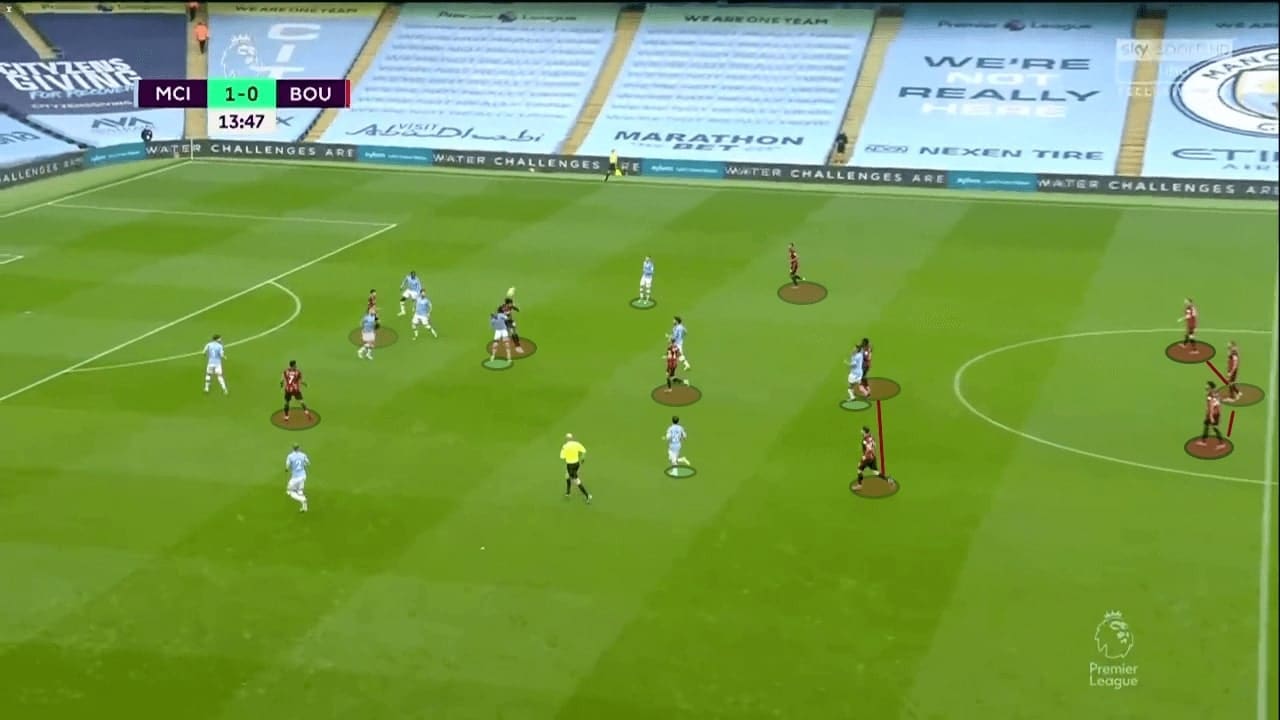
Howe’s men prepared to attack the left-back – Mendy and Oleksandr Zinchenko later on. By the extremely compact structure that helped to win the second balls, the backline might restart an attack. City suffered a lot when trying to set a pressing trap, which was incomplete and spaces were always available on the flank.
This was how Bournemouth entered the final third easily. Below, Mendy was occupied by Billing and the Cherries bypassed the entire City midfield with this pass. Here, Jesus was unaware of the player behind him as he was trying to push the line high.
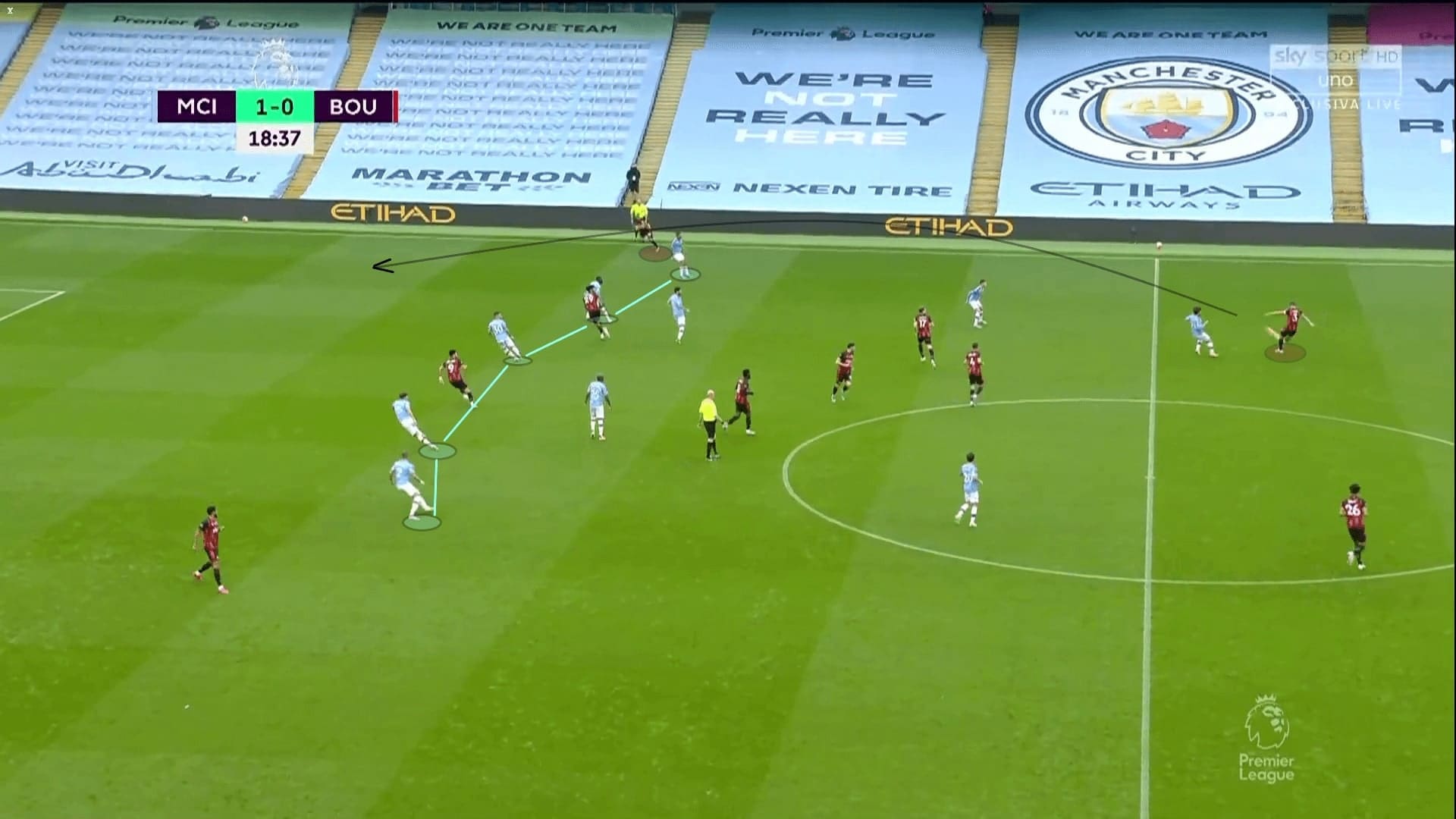
The standard of City’s transitions also dropped compared to the previous games. The players were a bit sloppy in terms of the positionings and it was difficult to trigger the counter-attacks.
As an example, when Bournemouth were attacking through the direct attacks as we have shown above, large numbers of players were committed. This included the whole midfield line, which was set at the edge of the penalty box. Considering Fernandinho and Gündoğan would retreat to defend in the box, the Cherries took advantage of these setups and controlled the transitions.
As a reference, D. Silva and Foden were available. However, none of the positionings could be a starting point of a counter-attack. Billing, the tall Danish midfielder, dominated the air battles and won the header to generate another wave of attack.
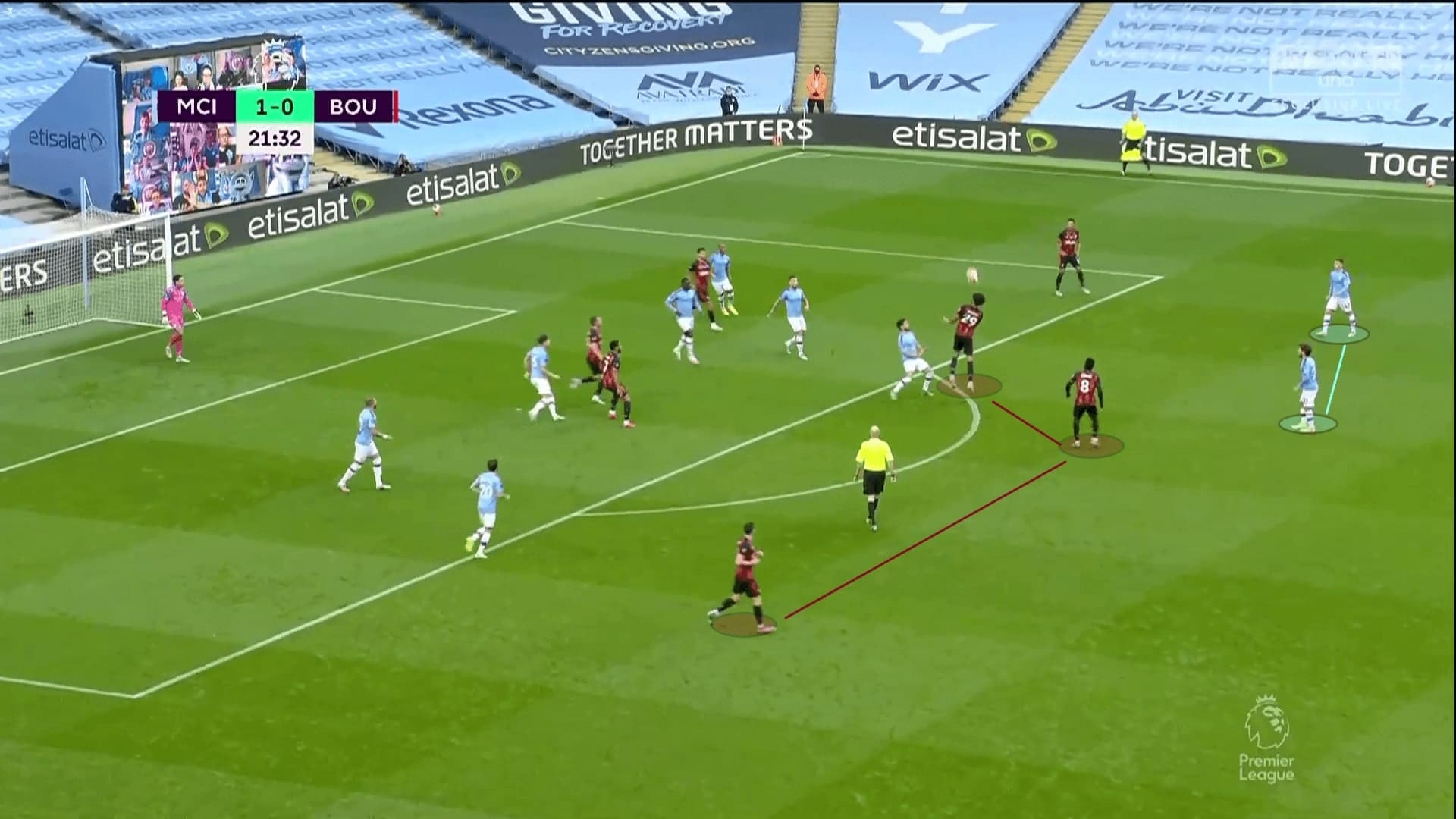
Guardiola’s problem-solving strategies
Since City were not good enough in the first half, Pep tweaked his tactics in the second half to try and keep the game in control. Two substitutions were made – Raheem Sterling came on for Bernardo Silva and Eric García came on for Walker. In my opinion, the shape was more like a 3-2-5 or a 2-3-5 after the changes.
That system can be seen in the image below, but it was flexible and changeable. García was given the freedom to join either line or stay between them as a connecting player. The greatest difference was the number of players between the lines. Now, all five vertical zones were occupied and the width was maintained. On top of that, two players could occupy each half-space without sacrificing other vertical zones.
This structure helped City to better control the midfield, especially on the Bournemouth second lines’ behaviour. The Cherries’ midfielders would have to worry about the players behind them when jumping out to press.
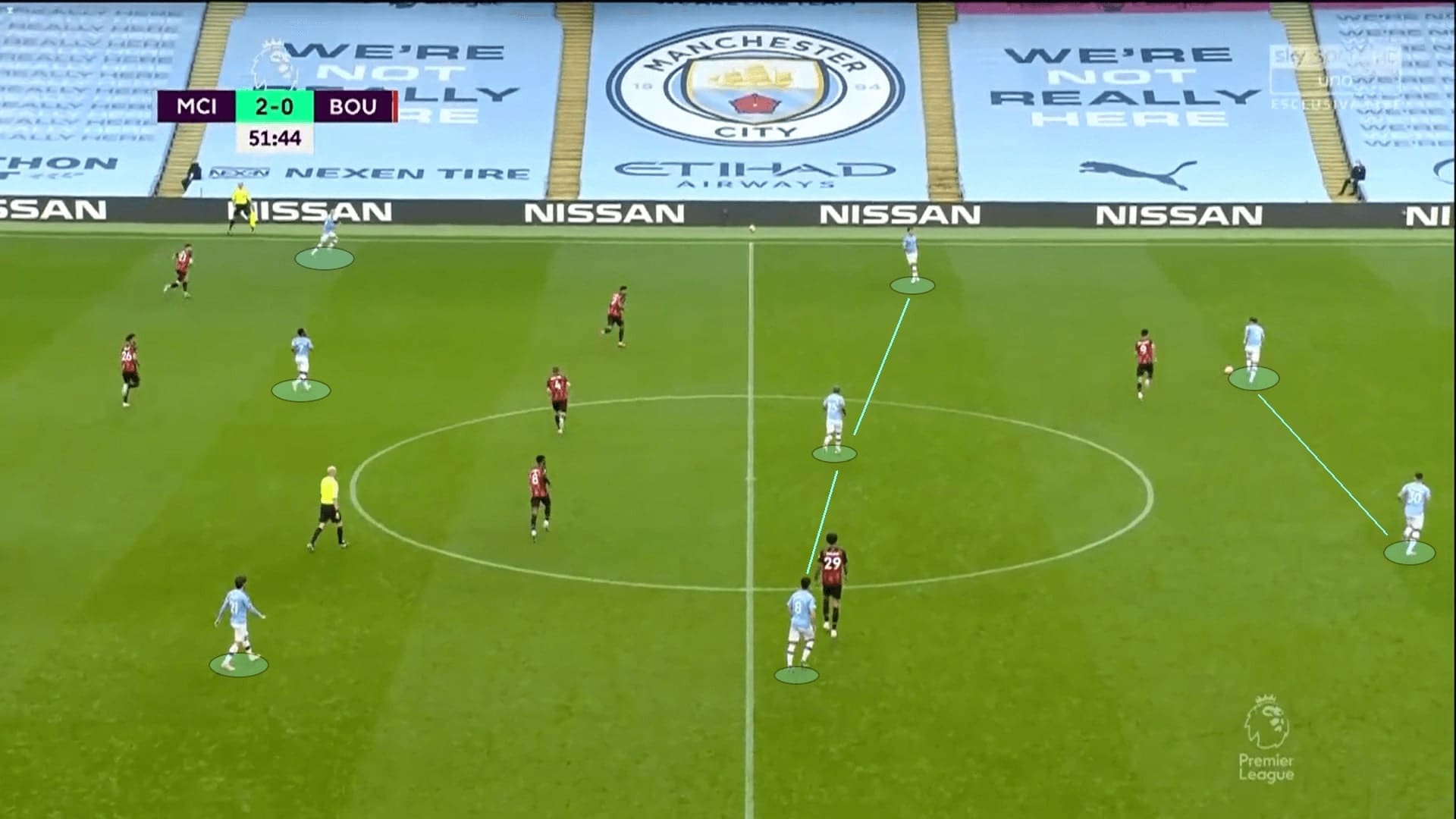
Also, Fernandinho was permitted to join the attack more often by staying behind the second line. It was unnecessary to stay deep as this only allowed one Bournemouth player to mark two players. Also, Fernandinho and Gündoğan were facing the pressure from the opposition midfielders when receiving the ball in front of the second line. This was risky.
So, Stones or García had the autonomy to carry the ball higher and play the progressive passes. Because of the initial deep positionings of the defenders, the Bournemouth pressing player was quite far away and the passer should have the time to pick an option.
In this example, Stones played a good pass that bypassed two lines and reached D. Silva, who could turn and face the defence directly. Even without Fernandinho in front of the Bournemouth midfield, City could do that and this was much better than the setup in the first half.
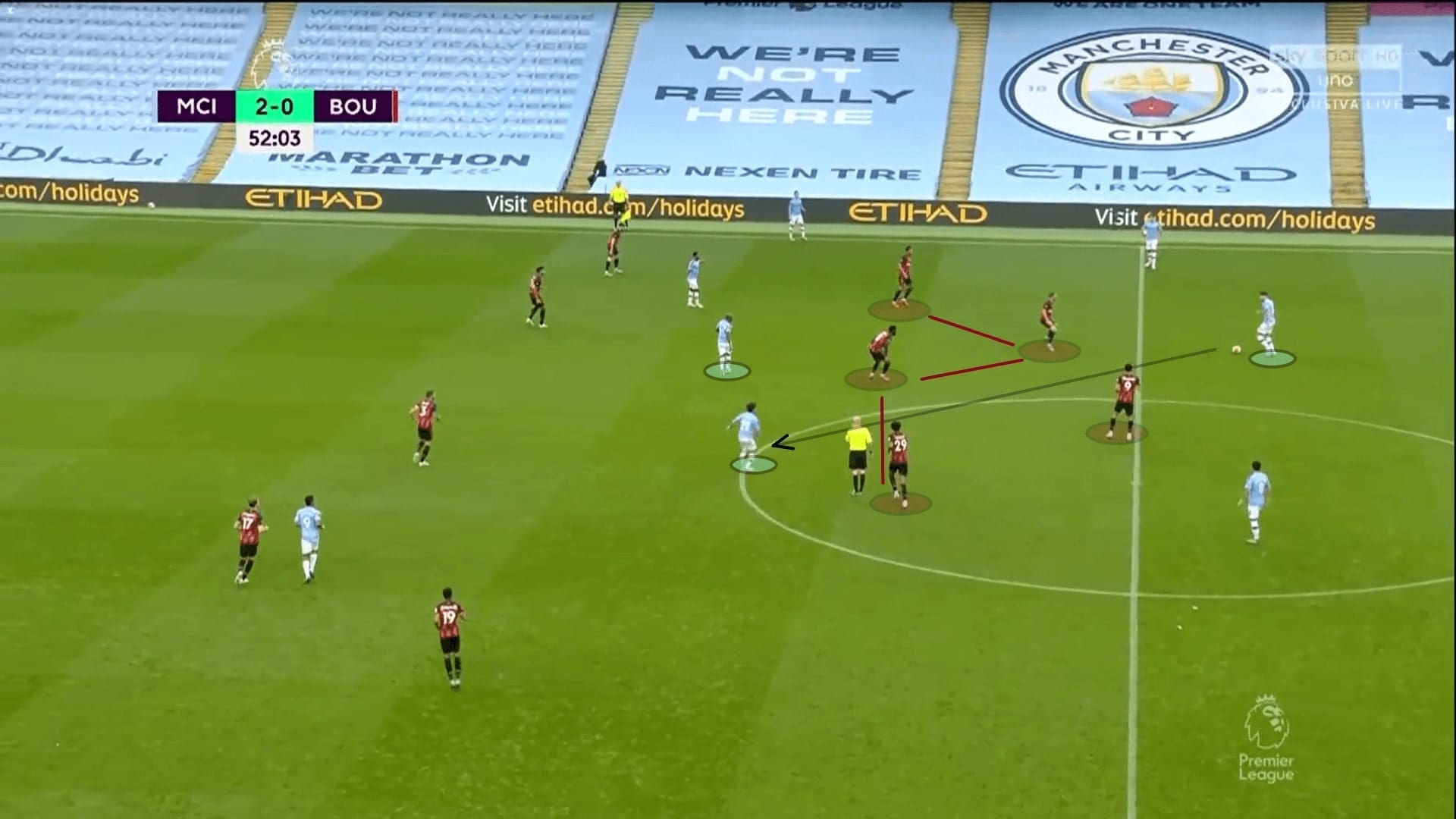
Therefore, City could organise the attack more often near the final third. The double-pivot could operate to move the ball away from the opponents in these situations. The Bournemouth midfielders were lured by the players between the lines, hence, now the shape was incomplete, and Rodrigo Hernández had the chance to develop the attack.
Since City were enjoying a two-goal advantage and the likes of Rodri and Fernandinho were not quick passers, the attack seldom developed with urgency and Bournemouth could reorganise their defence. Not many chances were created from these setups, but the stability of plays was better in general.
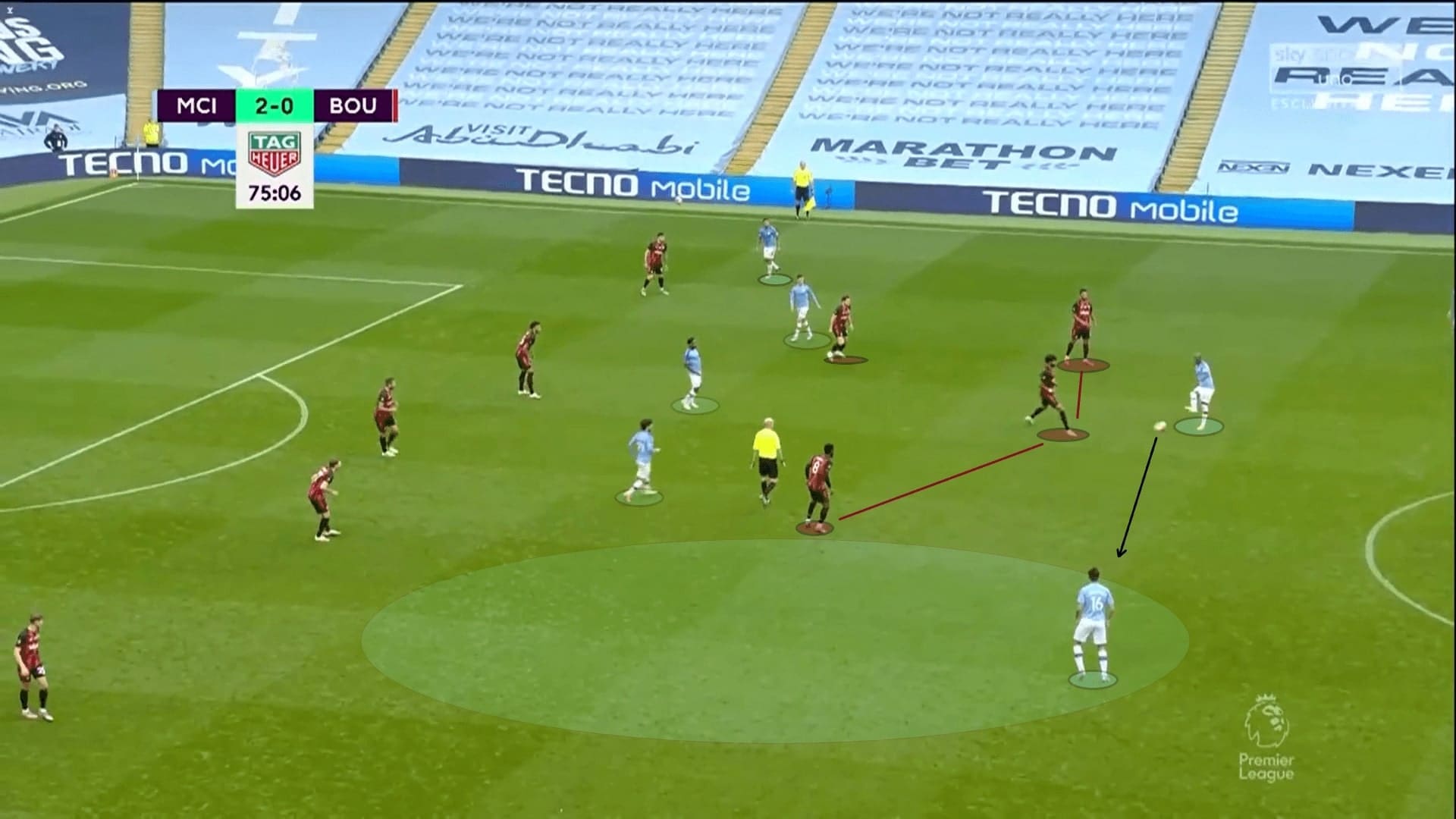
Final remarks
The performance of City was below par and maybe it was because of the players that were chosen. Neither Stones nor Otamendi should be the preferred starting centre-back as they were simply not on the level of Aymeric Laporte. Guardiola did show some interesting tactics – the use of hybrid players. We saw the idea, but the execution might not show what the coach was expecting. The choice of players should change again in the next game, which will be played at Wembley and against Arsenal.
Bournemouth were quite unlucky as some good chances were created but the goal-conversion ability was disappointing. The use of Billing in the set-pieces was a good one and City could not deal with the tall midfielder. There is still hope to survive in the Premier League, but they have to forget about this loss and win the remaining two games.





Comments